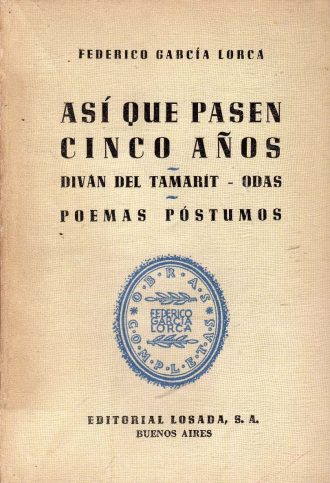
Twenty-two unfolded characters, anguished by time, frustration, love, inner journey, sterility and death inhabit Así que pasen cinco años (Once Five Years Pass. Legend of time in three acts and five paintings). The Young Man, the protagonist, represents all that and the other characters symbolize it, Lorca explains about the theme of his play in 1933. He adds, “It is a mystery, within the characteristics of this genre, a mystery about time, written in prose and verse.” Time destroys everything: “Sobre la misma columna [On the same column] / abrazados sueño y tiempo [embraced dream and time], /cruza el gemido del niño [crosses the moan of the child], / la lengua rota del viejo [the broken tongue of the old man].”
A Typist declares her love to a Young Man who does not reciprocate because he is waiting for his absent girlfriend to return. Five years later he goes to meet her and discovers that his girlfriend has eloped with a rugby player. He then remembers the love of the Typist, but when he goes to look for her she asks him to wait five years for her to marry him. He returns home and after a game of cards with some players who appear, he loses the ace of hearts and with it his life.
All this, in three acts where strange situations and very different characters appear, symbolic and creating an atmosphere of delirium.
During the author’s lifetime, preparations for the premiere began in the spring of 1936. Under the direction of Lorca himself, rehearsals began with the Club Anfistora. The process dragged on, Lorca could not find the right actors and the events of July 1936 cut the project short. “In four or five years there is a pit into which we will all fall,” Lorca writes. That the play is full of fatal omens is a fact. Just as, like The public, it jumps right into Lorca’s “impossible theater.”
In July 1931, Federico García Lorca wrote to Carlos Morla Lynch from Huerta de San Vicente (San Vicente Farmhouse). In the letter, he proposes giving a lecture on the “new play” he was writing, at the Morla’s house in Madrid. In successive letters he keeps him informed of the progress of the play. The lecture takes place in the fall.
The autographed manuscript presents, at the end of the last act, “Granada, August 19, 1931 – Huerta de San Vicente (San Vicente Farmhouse)”. As in the case of El público (The Public), the manuscript was given by Lorca to his friend Rafael Martínez Nadal, who reproduced a photostatic copy of it in 1979. Also preserved is the typed copy with Lorca’s corrections, the one used for rehearsals with the Club Anfistora. The García Lorca Archive preserves six typewritten pages.
Part of the work is formed by the memories of the popular songs of the long childhood lived by the author in the Vega of Granada.
Video summary of the performance of Once five years pass. National Drama Center.
National Drama Center. The Lorca’s ‘Impossible’ Theatre Staged.